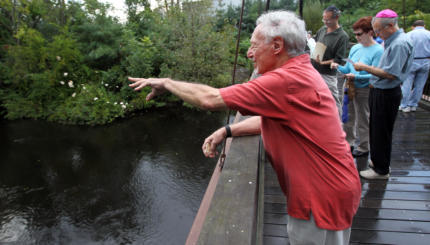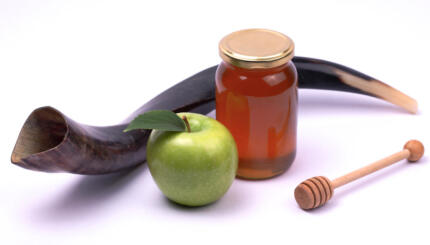Gathering with family over large meals, taking our usual seat in the synagogue, singing classic melodies and hearing the shofar blown in a beautiful sanctuary — for many of us, these are linchpins of the High Holiday season.
But even when those things are unavailable to us, we can still have a meaningful High Holiday experience. Rosh Hashanah celebrates the creation of the world. And when the familiar parts of the holiday are absent, we still have an opportunity to create a new experience of the High Holidays at home.
As you think about celebrating the holidays at home, here some questions to consider:
- Do you want to try to replicate a traditional synagogue experience at home or try something completely different?
- Who are the people you want to share this holiday with?
- What are the songs, smells, and tastes you associate with the holiday?
- What are the key traditionsI want to perform for myself or share with my family?
- What do I need spiritually and emotionally right now? And how might I design a holiday experience that meets me where I am?
With these questions in mind, here are some suggestions to help you create a meaningful High Holidays experience by yourself or with a small group at home.
With your help, My Jewish Learning can provide endless opportunities for learning, connection and discovery.
Get Ready
The High Holidays are a time of preparation. In fact, Jewish tradition teaches that the entire month of Elul that immediately precedes the High Holidays is meant to be a time of reflection and spiritual preparation. Between Rosh Hashanah and Yom Kippur is another preparatory period, the Ten Days of Repentance, when we closely examine our deeds and repair broken relationships. Use these times well.
- Get a jar: Keep a glass jar in a place that you see often. In the days leading up to Rosh Hashanah, write notes and place them in the jar — the name of someone you want to pray for, a question you want to ask, a character trait you want to work on. This will help you get into the mindset of this time of year and give you something to focus on during your prayers. Watch the jar fill up as Rosh Hashanah approaches.
- Start studying: A profusion of online classes are available. Sign up for one or two. Or check out My Jewish Learning’s extensive library of High Holiday articles and preparatory webinars.
Create the Mood
Even when we are unable to attend a synagogue in person, we can still create a makom tefillah, a place of prayer, in our homes.
- Pick a spot. Choose an area of your house to designate for prayer? What energy do you want it to have? Which chair will you use? What will you look at? Consider placing pictures of family and Jewish books in the space, or covering up electronics or other items that might distract you from your prayers.
- Get dressed up. Dressing up for the holiday creates a feeling of nobility and importance. Some people wear a kittel, a traditional white garment, to symbolize the purity of the day. What can you wear that will evoke specialness? This could be something new or putting on a garment with special meaning.
- Create some sound. Rosh Hashanah and Yom Kippur are associated with classic melodies unique to these days. What tunes do you want to learn in advance so you can make sure to sing them as you pray? Click here to learn some of the classics.
Get Cooking
Like all Jewish holidays, food is an essential piece of the Rosh Hashanah experience.
- Do it with family: Just because we’re physically separate doesn’t mean we can’t cook with our family. This can take the form of cooking together on a video call or simply preparing the same recipe. It might even be an opportunity to share reminiscences about a beloved recipe you’re eaten before.
- Be symbolic: Part of the fun of Rosh Hashanah is the simanim, or symbolic foods like apples and honey that we eat to have a sweet year, or a fish head to represent the hope that we finish first in our endeavors. What symbolic foods can you create for your family? Maybe take advantage of the sourdough craze to symbolize our hope to be “rolling in dough” next year. Or jump on the whipped coffee trend as a sign of a “wakeful” year. Have fun with it!
Do It With Others
For many of us, the High Holidays are a time to come together as a community. It may feel strange not to be praying in a room with others on the holiday. But there are still ways to create a sense of togetherness anyway.
- Get on video: If you don’t use electronics on the holiday, schedule a video call in advance to give friends and family blessings for a sweet new year. Consider expressing one wish that you want to send to your loved ones as they enter the holiday.
- Time it right: Think about asking your family to do one (or a few) things at the same time, either during prayers or meals.
- Put it in the mail: Ask family and friends to send you a letter in the mail — a lovely departure from our current dependence on screens. Maybe they’re reflections on the past year or ideas about ways to bring holiness to the world in the year to come. Maybe they’re just personal messages. Whatever they are, read them aloud to yourself on the holiday.
Sounding the Inner Shofar
The core ritual of Rosh Hashanah is the sounding of the shofar. If you can’t get to hear the shofar in person, here are some alternatives.
- Connect with intention: The purpose of the shofar is help us connect with our inner truth, to evoke repentance and mimic the sound of crying. This can be done through simple breathing. Try setting an intention of something you want to bring into your life this year (inhale) and something you want to remove from your life this year (exhale).
- The shofar as breath: This can be taken even further by breathing in the form of the shofar sounds. For the long single tone known as tekiah, take one deep breath in and exhale. For the three shorter tones known as shevarim, take three deep breaths and exhale completely after each. For the quick bursts known as t’ruah, take seven quick breaths with quick bursts of exhales. And for the final tekiah gedolah, take one final deep breath and exhale all the air from your lungs. Repeat this three times. Notice the impact on your body and revisit your intentions. How do you think and feel about them? Where did your mind go while you were breathing the shofar?



